Pt/Nb2O5-Al2O3 Catalysts for the Hydrogenation and Reductive Amination of Furfural
Abstract
1. Introduction
2. Results and Discussion
2.1. Catalyst Characterization
2.2. Catalytic Activity
2.2.1. Furfural Hydrogenation
2.2.2. Reductive Amination of Furfural
3. Materials and Methods
3.1. Synthesis of Catalysts
3.1.1. Catalyst Characterization
3.1.2. Catalytic Studies
4. Conclusions
Supplementary Materials
Author Contributions
Funding
Data Availability Statement
Acknowledgments
Conflicts of Interest
References
- Esteves, L.M.; Brijaldo, M.H.; Oliveira, E.G.; Martinez, J.J.; Rojas, H.; Caytuero, A.; Passos, F.B. Effect of support on selective 5-hydroxymethylfurfural hydrogenation towards 2, 5-dimethylfuran over copper catalysts. Fuel 2020, 270, 117524. [Google Scholar] [CrossRef]
- Salnikova, K.; Matveeva, V.; Bykov, A.; Demidenko, G.; Shkileva, G.; Sulman, I. The Liquid Phase Catalytic Hydrogenation of the Furfural to Furfuryl Alcohol. Chem. Eng. Trans. 2018, 70, 379–384. [Google Scholar] [CrossRef]
- Li, D.; Zhang, J.; Liu, Y.; Yuan, H.; Chen, Y. Boron doped magnetic catalysts for selective transfer hydrogenation of furfural into furfuryl alcohol. Chem. Eng. Sci. 2021, 229, 116075. [Google Scholar] [CrossRef]
- Wang, Y.; Gao, T.; Lu, Y.; Wang, Y.; Cao, Q.; Fang, W. Efficient hydrogenation of furfural to furfuryl alcohol by magnetically recoverable RuCo bimetallic catalyst. Green Energy Environ. 2022, 7, 275–287. [Google Scholar] [CrossRef]
- Gandarias, I.; García-Fernández, S.; Obregón, I.; Agirrezabal-Telleria, I.; Arias, P.L. Production of 2-methylfuran from biomass through an integrated biorefinery approach. Fuel Process. Technol. 2018, 178, 336–343. [Google Scholar] [CrossRef]
- Rojas, H.; Martínez, J.J.; Reyes, P. Kinetic behavior in the hydrogenation of furfural over Ir catalysts supported on TiO2. DYNA 2010, 77, 151–159. [Google Scholar]
- Claus, P. Selective hydrogenation of α,β-unsaturated aldehydes and other C=O and C=C bonds containing compounds. Top. Catal. 1998, 5, 51–62. [Google Scholar] [CrossRef]
- Villaverde, M.M.; Garetto, T.F.; Marchi, A.J. Liquid-phase transfer hydrogenation of furfural to furfuryl alcohol on Cu–Mg–Al catalysts. Catal. Commun. 2015, 58, 6–10. [Google Scholar] [CrossRef]
- Bhogeswararao, S.; Srinivas, D. Catalytic conversion of furfural to industrial chemicals over supported Pt and Pd catalysts. J. Catal. 2015, 327, 65–77. [Google Scholar] [CrossRef]
- Nguyen-Huy, C.; Lee, J.; Seo, J.H.; Yang, E.; Lee, J.; Choi, K.; Lee, H.; Kim, J.H.; Lee, M.S.; Joo, S.H.; et al. Structure-dependent catalytic properties of mesoporous cobalt oxides in furfural hydrogenation. Appl. Catal. A Gen. 2019, 583, 117125. [Google Scholar] [CrossRef]
- Yuan, Q.; Zhang, D.; Van Haandel, L.; Ye, F.; Xue, T.; Hensen, E.J.M.; Guan, Y. Selective liquid phase hydrogenation of furfural to furfuryl alcohol by Ru/Zr-MOFs. J. Mol. Catal. A Chem. 2015, 406, 58–64. [Google Scholar] [CrossRef]
- O’Driscoll, Á.; Leahy, J.J.; Curtin, T. The influence of metal selection on catalyst activity for the liquid phase hydrogenation of furfural to furfuryl alcohol. Catal. Today 2017, 279, 194–201. [Google Scholar] [CrossRef]
- Delbecq, F.; Sautet, P. Competitive C=C and C=O Adsorption of α-β-Unsaturated Aldehydes on Pt and Pd Surfaces in Relation with the Selectivity of Hydrogenation Reactions: A Theoretical Approach. J. Catal. 1995, 152, 217–236. [Google Scholar] [CrossRef]
- Pushkarev, V.; Musselwhite, N.; An, K.; Alayoglu, S.; Somorjai, G.A. High Structure Sensitivity of Vapor-Phase Furfural Decarbonylation/ Hydrogenation Reaction Network as a Function of Size and Shape of Pt Nanoparticles. Nano Lett. 2012, 12, 5196–5201. [Google Scholar] [CrossRef] [PubMed]
- Jouve, A.; Cattaneo, S.; Delgado, D.; Scotti, N.; Evangelisti, C.; López Nieto, M.J.; Prati, L. Furfural Hydrogenation on Modified Niobia. Appl. Sci. 2019, 9, 2287. [Google Scholar] [CrossRef]
- Du, H.; Ma, X.; Yan, P.; Jiang, M.; Zhao, Z.; Zhang, Z.C. Catalytic furfural hydrogenation to furfuryl alcohol over Cu/SiO2 catalysts: A comparative study of the preparation methods. Fuel Process. Technol. 2019, 193, 221–231. [Google Scholar] [CrossRef]
- Yang, X.; Meng, Q.; Ding, G.; Wang, Y.; Chen, H.; Zhu, Y.L.; Li, Y.W. Construction of novel Cu/ZnO-Al2O3 composites for furfural hydrogenation: The role of Al components. Appl. Catal. A Gen. 2018, 561, 78–86. [Google Scholar] [CrossRef]
- Manikandan, M.; Venugopal, A.K.; Prabu, K.; Jha, R.K.; Thirumalaiswamy, R. Role of surface synergistic effect on the performance of Ni-based hydrotalcite catalyst for highly efficient hydrogenation of furfural. J. Mol. Catal. A Chem. 2016, 417, 153–162. [Google Scholar] [CrossRef]
- Maderuelo-Solera, R.; López-Asensio, R.; Cecilia, J.A.; Jiménez-Gómez, C.P.; García-Sancho, C.; Moreno-Tost, R.; Maireles-Torres, P. Catalytic transfer hydrogenation of furfural to furfuryl alcohol over calcined MgFe hydrotalcites. Appl. Clay Sci. 2019, 183, 105351. [Google Scholar] [CrossRef]
- Jackson, M.A.; White, M.G.; Haasch, R.T.; Peterson, S.C.; Blackburn, J.A. Hydrogenation of furfural at the dynamic Cu surface of CuOCeO2/Al2O3 in a vapor phase packed bed reactor. Mol. Catal. 2018, 445, 124–132. [Google Scholar] [CrossRef]
- Li, M.; Hao, Y.; Cárdenas-Lizana, F.; Keane, M.A. Selective production of furfuryl alcohol via gas phase hydrogenation of furfural over Au/Al2O3. Catal. Commun. 2015, 69, 119–122. [Google Scholar] [CrossRef]
- Dong, C.; Wang, H.; Du, H.; Peng, J.; Cai, Y.; Guo, S.; Zhang, J.; Samart, C.; Ding, M. Ru/HZSM-5 as an efficient and recyclable catalyst for reductive amination of furfural to furfurylamine. Mol. Catal. 2020, 482, 110755. [Google Scholar] [CrossRef]
- Martínez, J.J.; Nope, E.; Rojas, H.; Brijaldo, M.H.; Passos, F.; Romanelli, G. Reductive amination of furfural over Me/SiO2-SO3H (Me: Pt, Ir, Au) catalysts. J. Mol. Catal. A Chem. 2014, 392, 235–240. [Google Scholar] [CrossRef]
- Reddy, P.S.; Kanjilal, S.; Sunitha, S.; Prasad, R.B.N. Reductive amination of carbonyl compounds using NaBH4 in a Brønsted acidic ionic liquid. Tetrahedron Lett. 2007, 48, 8807–8810. [Google Scholar] [CrossRef]
- Domine, M.E.; Hernández-Soto, M.C.; Navarro, M.T.; Pérez, Y. Pt and Pd nanoparticles supported on structured materials as catalysts for the selective reductive amination of carbonyl compounds. Catal. Today 2011, 172, 13–20. [Google Scholar] [CrossRef]
- Bagal, D.B.; Watile, R.A.; Khedkar, M.V.; Dhake, K.P.; Bhanage, B.M. PS-Pd–NHC: An efficient and heterogeneous recyclable catalyst for direct reductive amination of carbonyl compounds with primary/secondary amines in aqueous medium. Catal. Sci. Technol. 2012, 2, 354–358. [Google Scholar] [CrossRef]
- Chandra, D.; Inoue, Y.; Sasase, M.; Kitano, M.; Bhaumik, A.; Kamata, K.; Hosono, H.; Hara, M. A high performance catalyst of shape-specific ruthenium nanoparticles for production of primary amines by reductive amination of carbonyl compounds. Chem. Sci. 2018, 9, 5949–5956. [Google Scholar] [CrossRef] [PubMed]
- Liu, Y.; Zhou, K.; Shu, H.; Liu, H.; Lou, J.; Guo, D.; Wei, Z.; Li, X. Switchable synthesis of furfurylamine and tetrahydrofurfurylamine from furfuryl alcohol over RANEY® nickel. Catal. Sci. Technol. 2017, 7, 4129–4135. [Google Scholar] [CrossRef]
- Nakamura, Y.; Kon, K.; Touchy, A.S.; Shimizu, K.; Ueda, W. Selective Synthesis of Primary Amines by Reductive Amination of Ketones with Ammonia over Supported Pt catalysts. ChemCatChem 2015, 7, 921–924. [Google Scholar] [CrossRef]
- Liang, G.; Wang, A.; Li, L.; Xu, G.; Yan, N.; Zhang, T. Production of Primary Amines by Reductive Amination of Biomass-Derived Aldehydes/Ketones. Angew. Chem. Int. Ed. 2017, 56, 3050–3054. [Google Scholar] [CrossRef] [PubMed]
- Tran, S.B.T.; Choi, H.; Oh, S.; Park, J.Y. Influence of Support Acidity of Pt/Nb2O5 Catalysts on Selectivity of CO2 Hydrogenation. Catal. Lett. 2019, 149, 2823–2835. [Google Scholar] [CrossRef]
- Rodrigues, R.; Isoda, N.; Gonçalves, M.; Figueiredo, F.C.A.; Mandelli, D.; Carvalho, W.A. Effect of niobia and alumina as support for Pt catalysts in the hydrogenolysis of glycerol. Chem. Eng. J. 2012, 198–199, 457–467. [Google Scholar] [CrossRef]
- Ma, L.; Yan, L.; Lu, A.-H.; Ding, Y. Effect of Re promoter on the structure and catalytic performance of Ni–Re/Al2O3 catalysts for the reductive amination of monoethanolamine. RSC Adv. 2018, 8, 8152–8163. [Google Scholar] [CrossRef] [PubMed]
- Jiao, H.; Zhao, X.; Lv, C.; Wang, Y.; Yang, D.; Li, Z.; Yao, X. Nb2O5-γ-Al2O3 nanofibers as heterogeneous catalysts for efficient conversion of glucose to 5-hydroxymethylfurfural. Sci. Rep. 2016, 6, 34068. [Google Scholar] [CrossRef] [PubMed]
- Gutierrez, L.F.; Nope, E.; Rojas, H.A.; Cubillos, J.A.; Sathicq, A.G.; Romanelli, G.P.; Martinez, J.J. New application of decaniobate salt as basic solid in the synthesis of 4H-pyrans by microwave assisted multicomponent reactions. Res. Chem. Intermed. 2018, 44, 5559–5568. [Google Scholar] [CrossRef]
- Selvanathan, V.; Shahinuzzaman, M.; Selvanathan, S.; Sarkar, D.; Algethami, N.; Alkhammash, H.I.; Anuar, F.H.; Zainuddin, Z.; Aminuzzaman, M.; Abdullah, H.; et al. Phytochemical -Assisted Green Synthesis of Nickel Oxide Nanoparticles for Application as Electrocatalysts in Oxygen Evolution Reaction. Catalysts 2021, 11, 1523. [Google Scholar] [CrossRef]
- Lima, S.; García-López, E.I.; Krivtsov, I.; Ilkaeva, M.; Bornes, C.; Mafra, L.; Liotta, L.F.; Villar-Rodil, S.; Paredes, J.I.; Marcì, G.; et al. Valorisation of microalga Chlorella sp. into furans in the presence of Nb2O5 catalysts. J. Catal. 2024, 433, 115457. [Google Scholar] [CrossRef]
- Raba, A.M.; Bautista-Ruíz, J.; Joya, M. Synthesis and Structural Properties of Niobium Pentoxide Powders: A Comparative Study of the Growth Process. Mater. Res. 2016, 19, 1381–1387. [Google Scholar] [CrossRef]
- Yang, D.; Huang, J.; Hu, Z.; Qin, S.; Mu, J.; Wang, F.; Zhang, Z.; Xie, Y.; Liu, S.; Wang, Q. Catalytic pyrolysis of lignin to aromatic hydrocarbons over Nb/Al oxide catalyst. Energy 2024, 302, 131764–131773. [Google Scholar] [CrossRef]
- Kreissl, H.T.; Li, M.M.J.; Peng, Y.K.; Nakagawa, K.; Hooper, T.J.N.; Hanna, J.V.; Shepherd, A.; Wu, T.S.; Soo, L.Y.; Tsang, S.C.E. Structural Studies of Bulk to Nanosize Niobium Oxides with Correlation to Their Acidity. J. Am. Chem. Soc. 2017, 139, 12670–12680. [Google Scholar] [CrossRef] [PubMed]
- Wachs, I.E. Raman and IR studies of surface metal oxide species on oxide supports: Supported metal oxide catalysts. Catal. Today 1996, 27, 437–455. [Google Scholar] [CrossRef]
- González, G.; Saraiva, S.M.; Aliaga, W. Isoelectric points for niobium and vanadium pentoxides. J. Dispers. Sci. Technol. 1994, 15, 249. [Google Scholar] [CrossRef]
- Gulicovski, J.J.; Čerović, L.S.; Milonjić, S.K. Point of zero charge and isoelectric point of alumina. Mater. Manuf. Process. 2008, 23, 615–619. [Google Scholar] [CrossRef]
- Nascimento, J.P.; Oton, L.F.; Oliveira, A.C.; Rodríguez-Aguado, E.; Rodríguez-Castellón, E.; Araujo, R.S.; Souza, M.S.; Lang, R. Selective Catalytic Reduction of NOx by CO over Doubly Promoted MeMo/Nb2O5 Catalysts (Me = Pt, Ni, or Co). Catalysts 2020, 10, 1048. [Google Scholar] [CrossRef]
- Eckardt, M.; Gebauer, C.; Jusys, Z.; Wassner, M.; Hüsing, N.; Behm, R.J. Oxygen reduction reaction activity and long-term stability of platinum nanoparticles supported on titania and titania-carbon nanotube composites. J. Power Sources 2018, 400, 580–591. [Google Scholar] [CrossRef]
- Lee, W.J.; Park, D.H.; Lee, H.J.; Byeon, J.H.; Kim, M.H.; Park, K.W. Enhanced oxygen reduction reaction performance of Pt catalysts on Nb2O5 nanoparticles decorated carbon nanostructures. Mater. Sci. Eng. B 2023, 289, 116253. [Google Scholar] [CrossRef]
- Su, K.; Wang, Y.; Zhang, C.; Gao, Z.; Han, J.; Wang, F. Tuning the Pt species on Nb2O5 by support-induced modification in the photocatalytic transfer hydrogenation of phenylacetylene. Appl. Catal. B Environ. 2021, 298, 120554. [Google Scholar] [CrossRef]
- Wu, H.; Sui, X.; Lei, Y.; Liu, L.; Xu, W.; Liang, G.; Li, C.; Li, X. Compositing of Co3O4 with boron nitride to promote the catalytic performance for methane oxidation. Fuel 2024, 369, 131786–131793. [Google Scholar] [CrossRef]
- Fuente-Hernández, A.; Lee, R.; Béland, N.; Zamboni, I.; Lavoie, J.M. Reduction of Furfural to Furfuryl Alcohol in Liqui Phase over a Biochar-Supported Platinum Catalyst. Energies 2017, 10, 286. [Google Scholar] [CrossRef]
- Kuhaudomlap, S.; Mekasuwandumrong, O.; Praserthdam, P.; Fujita, S.I.; Arai, M.; Panpranot, J. The H2-Treated TiO2 Supported Pt Catalysts Prepared by Strong Electrostatic Adsorption for Liquid-Phase Selective Hydrogenation. Catalysts 2018, 8, 87. [Google Scholar] [CrossRef]
- Saknaphawuth, S.; Weerachawanasak, P.; Chuenchom, L.; Praserthdam, P.; Panpranot, J. Liquid-Phase Selective Hydrogenation of Furfural to Furfuryl Alcohol over Ferromagnetic Element (Fe, Co, Ni, Nd)-Promoted Pt Catalysts Supported on Activated Carbon. Catalysts 2022, 12, 393. [Google Scholar] [CrossRef]
- Taylor, M.J.; Durndell, L.J.; Isaacs, M.A.; Parlett, C.M.A.; Wilson, K.; Lee, A.F.; Kyriakou, G. Highly selective hydrogenation of furfural over supported Pt nanoparticles under mild conditions. Appl. Catal. B 2016, 180, 580–585. [Google Scholar] [CrossRef]
- Dohade, M.G.; Dhepe, P.L. One pot conversion of furfural to 2-methylfuran in the presence of PtCo bimetallic catalyst. Clean Technol. Environ. Policy 2017, 20, 703–713. [Google Scholar] [CrossRef]
- Tian, Y.; Feng, Y.; Li, Z.; Fan, Y.; Sperry, J.; Sun, Y.; Yang, S.; Tang, X.; Lin, L.; Zeng, X. Green and efficient selective hydrogenation of furfural to furfuryl alcohol over hybrid CoOx/Nb2O5 nanocatalyst in water. Mol. Catal. 2023, 538, 112981. [Google Scholar] [CrossRef]
- Gou, L.; Xie, L.; Wang, Y.; Dai, L. Efficient conversion of furfural to furfural amine over 4Ru1Co/AC catalyst. Appl. Catal. A 2022, 647, 118902. [Google Scholar] [CrossRef]
- Singh, G.; Kaishyop, J.; Singh, G.; Gazi, M.; Bag, A.; Samanta, C.; Bordolo, A. One-Pot direct reductive amination of furfural over Pd@CNTs. Mol. Catal. 2023, 535, 112877. [Google Scholar] [CrossRef]
- Wang, H.; Zhang, Y.; Luo, D.; Wang, H.; He, Y.; Wang, F.; Wen, X. Active metal dependent side reactions for the reductive amination of furfural. Mol. Catal. 2023, 536, 112914. [Google Scholar] [CrossRef]
- Ohlin, C.A.; Villa, E.M.; Casey, W.H. One-pot synthesis of the decaniobate salt [N(CH3)4]6[Nb10O28]·6H2O from hydrous niobium oxide. Inorg. Chim. Acta 2009, 362, 1391–1392. [Google Scholar] [CrossRef]

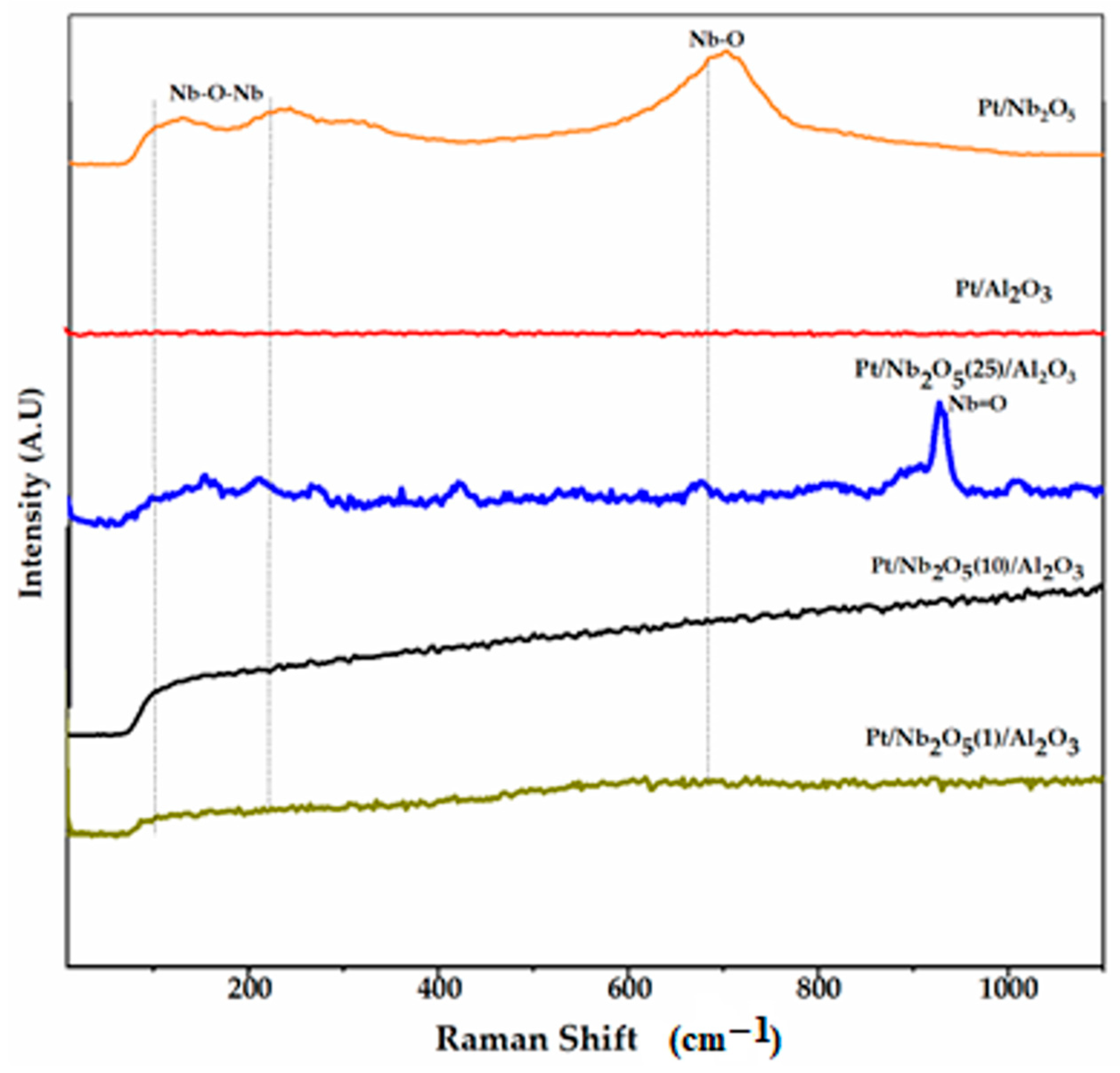

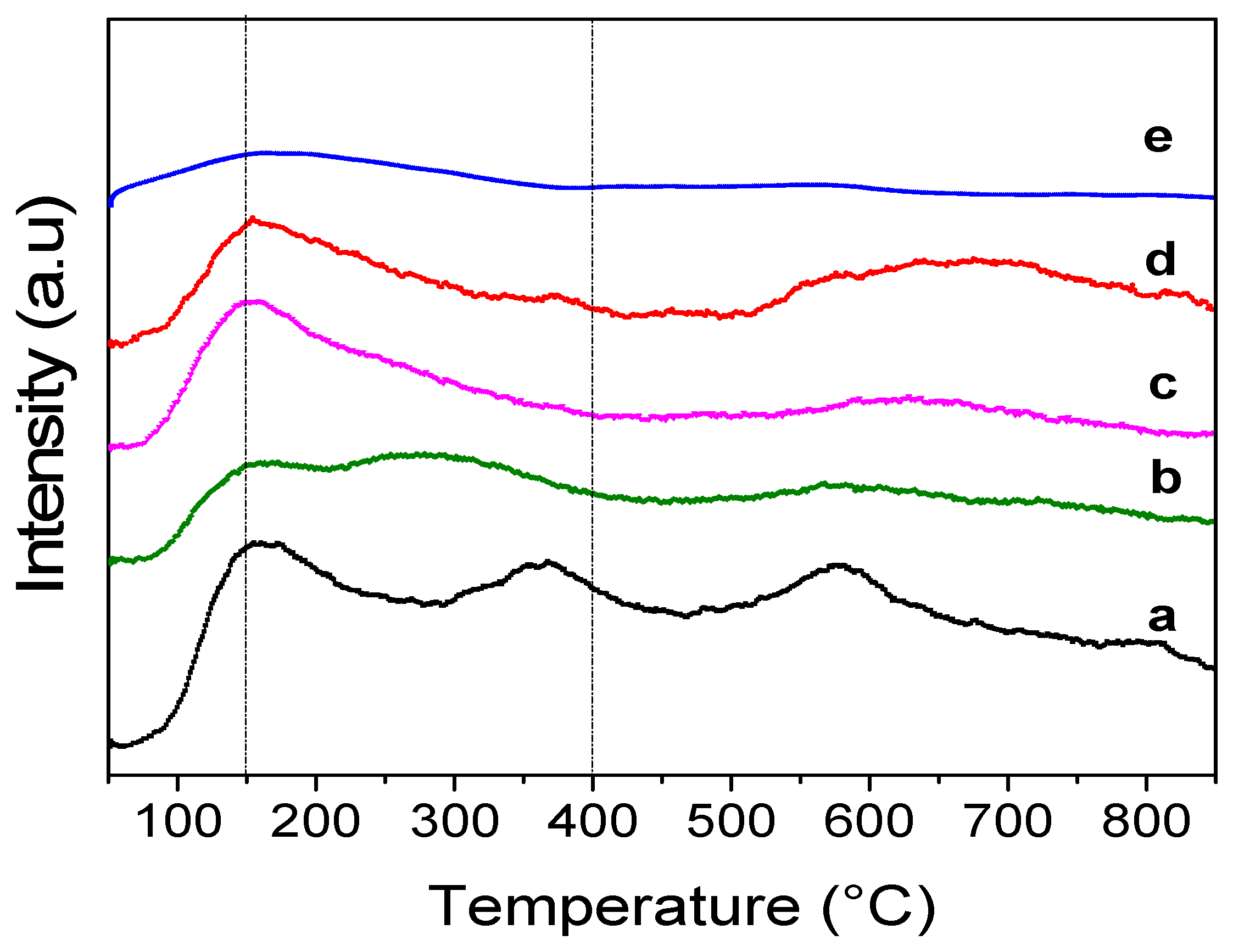

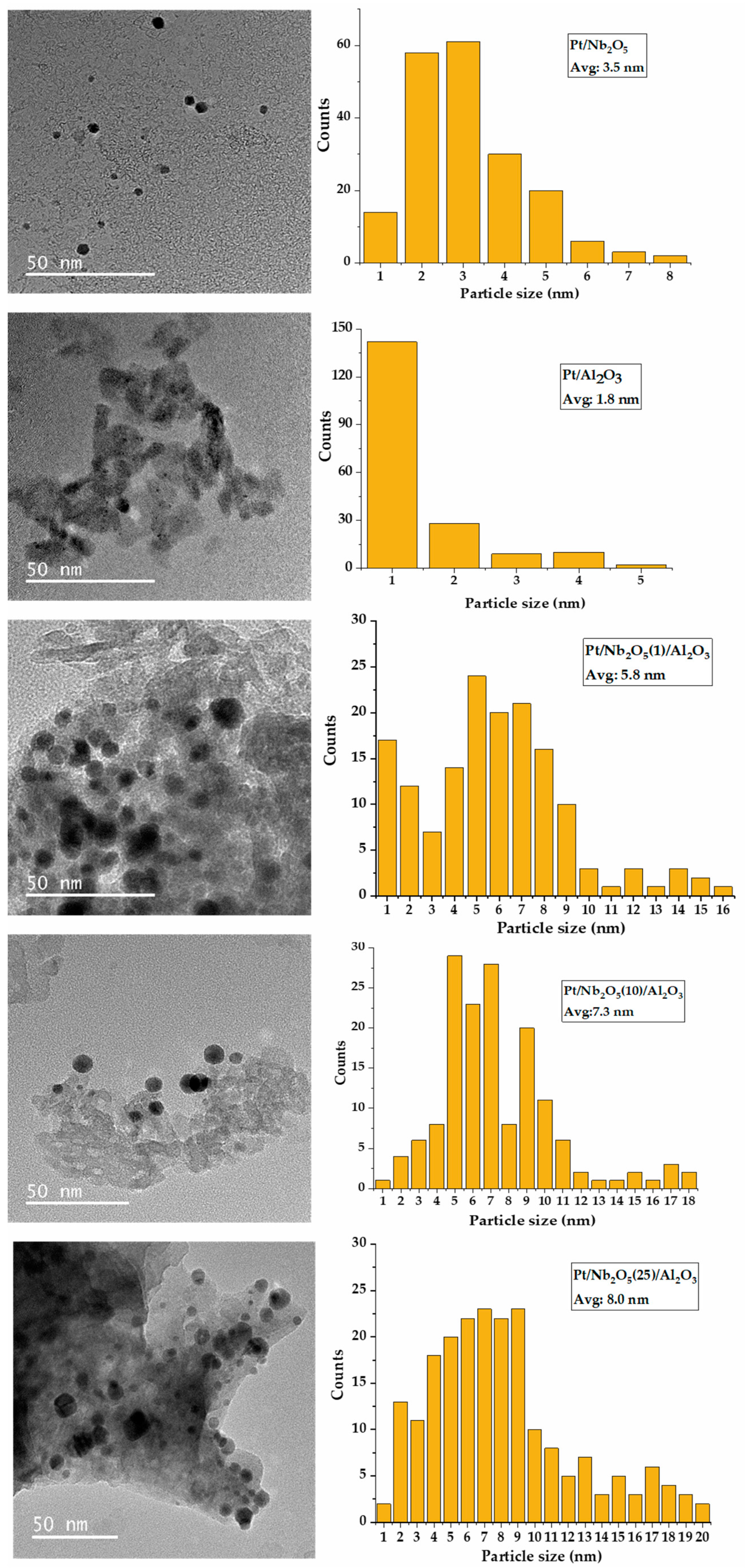

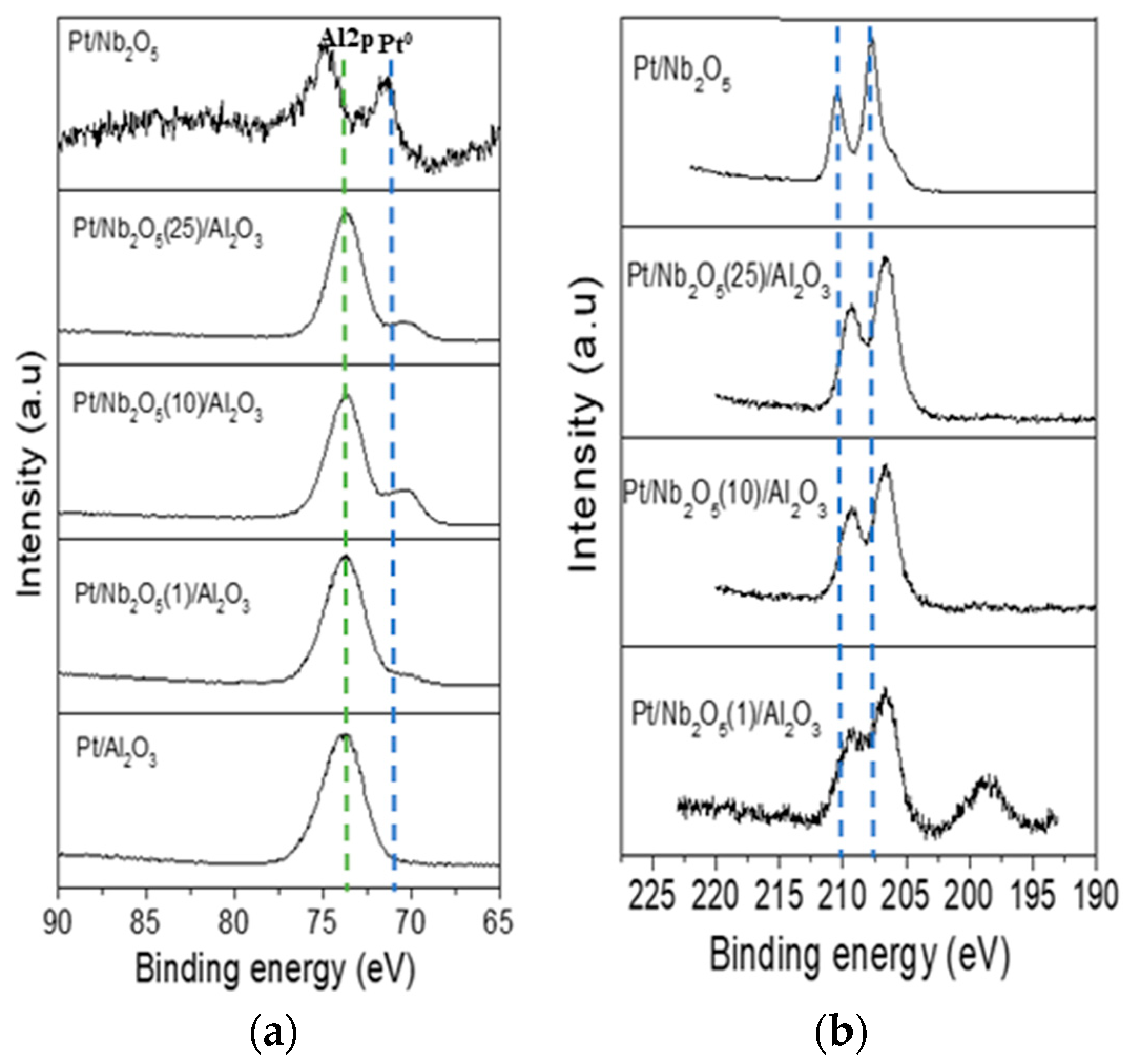
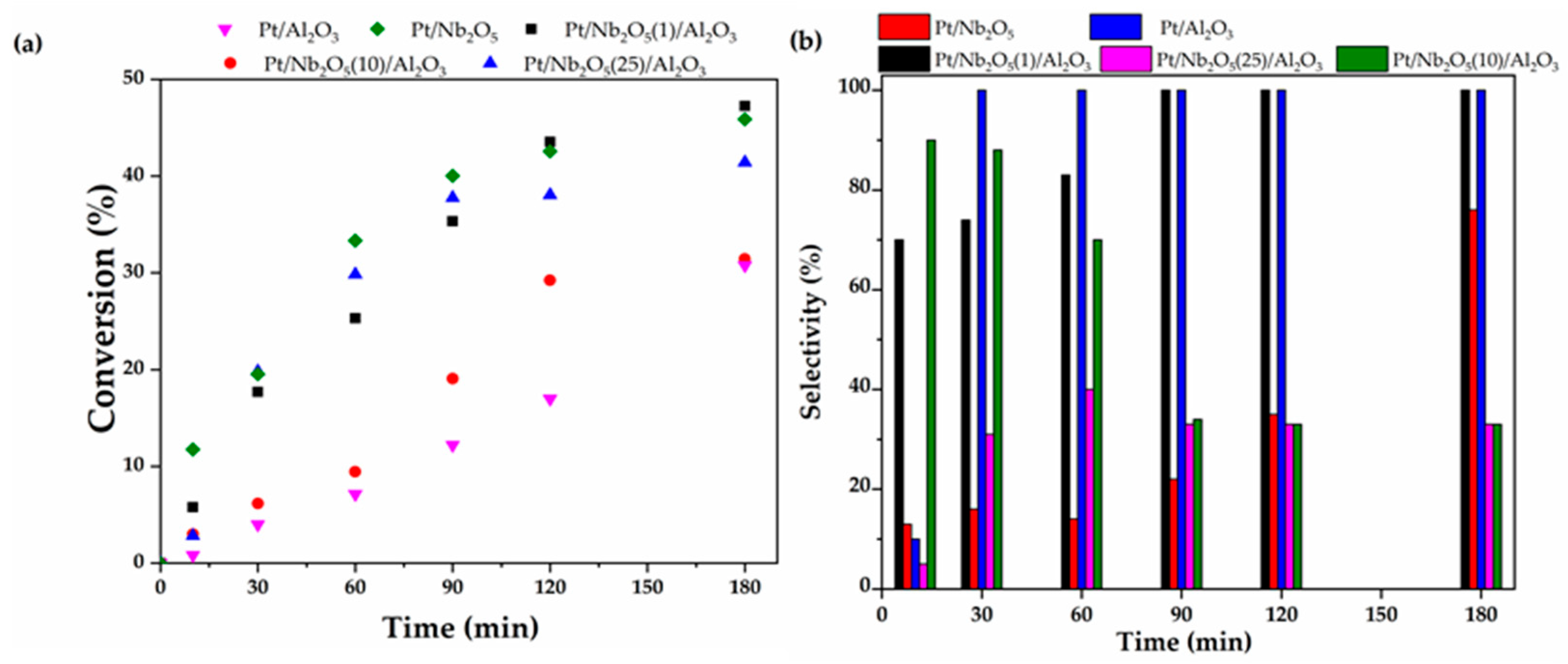

| Catalyst | SBET (m2/g) | Pore Diameter (nm) | Particle Size [a] (nm) | Dispersion [b] (%) |
|---|---|---|---|---|
| Pt/Al2O3 | 196 | 7.4 | 1.8 | 59 |
| Pt/Nb2O5 | 55 | 10.4 | 3.5 | 37 |
| Pt/Nb2O5(1)/Al2O3 | 175 | 9.8 | 5.8 | 54 |
| Pt/Nb2O5(10)/Al2O3 | 157 | 8.6 | 7.3 | 48 |
| Pt/Nb2O5(25)/Al2O3 | 214 | 7.6 | 8.0 | 45 |
| Catalyst | Pt/(Nb+Al) [a] | Nb/Al [a] | Total Acidity (/g cat.) |
|---|---|---|---|
| Pt/Al2O3 | 0.001 | – | 0.14 |
| Pt/Nb2O5 | 0.001 | 0.0039 | 0.03 |
| Pt/Nb2O5(1)/Al2O3 | 0.0023 | 0.0170 | 0.52 |
| Pt/Nb2O5(10)/Al2O3 | 0.0067 | 0.0232 | 0.77 |
| Pt/Nb2O5(25)/Al2O3 | 0.0041 | – | 1.03 |
| Catalyst | (−r)0 (μmol/s g cat) | TOF (s−1) |
|---|---|---|
| Pt/Al2O3 | 1.0 | 0.03 |
| Pt/Nb2O5 | 7.0 | 0.37 |
| Pt/Nb2O5(1)/Al2O3 | 7.0 | 0.25 |
| Pt/Nb2O5(10)/Al2O3 | 4.5 | 0.15 |
| Pt/Nb2O5(25)/Al2O3 | 5.7 | 0.25 |
| Catalyst | Furfural Conversion (%) | Selectivity Furfuryl Alcohol (%) | ||
|---|---|---|---|---|
| Run 1 | Run 2 | Run 1 | Run 2 | |
| Pt/Al2O3 | 25 | 23 | 96 | 95 |
| Pt/Nb2O5 | 42 | 40 | 72 | 70 |
| Pt/Nb2O5(1)/Al2O3 | 43 | 42 | 79 | 66 |
| Pt/Nb2O5(10)/Al2O3 | 28 | 25 | 30 | 26 |
| Pt/Nb2O5(25)/Al2O3 | 37 | 35 | 30 | 28 |
| Catalyst | Conversion (%) | Y Imine (%) | Y Amine (%) |
|---|---|---|---|
| Blank | 96 | 87 | – |
| Pt/Al2O3 | 67 | 48 | 9 |
| Pt/Nb2O5 | 82 | 47 | 18 |
| Pt/Nb2O5(1)/Al2O3 | 80 | 40 | 19 |
| Pt/Nb2O5(10)/Al2O3 | 82 | 40 | 23 |
| Pt/Nb2O5(25)/Al2O3 | 89 | 59 | 14 |
| Catalysts | wt% Metal | Preparation Method | Reaction Conditions | Reaction Time (h) | FAL Conversion (%) | FOL Selectivity (%) | Ref. |
|---|---|---|---|---|---|---|---|
| Pt/Nb2O5(1)/Al2O3 | 1 | Impregnation | 90 °C, 25 mg, 5 MPa H2 | 3 h | 47 | 99 | This work |
| Pt/TiO2 | 0.5 | Impregnation | 50 °C, 50 mg, 20 bar H2 | 2 h | 89 | 17.7 | [50] |
| Pt/AC | 0.5 | Impregnation | 50 °C, 50 mg, 20 bar H2 | 2 h | 53.9 | 58 | [51] |
| Pt/Al2O3 | 5.0 | Wet impregnation | 25 °C, 2 MPa H2 | 8 h | 30 | 99.1 | [9] |
| Pt/Al2O3 | 5.0 | Wet impregnation | 240 °C, 2 MPa H2 | 5 h | 100 | 30.7 | [9] |
| Pt/Al2O3 | 2.0 | - | 50 °C, Ambient | 7 h | 80 | 99 | [52] |
| Pt/BC | 3.0 | Wet impregnation | 210 °C, 10.3 MPa H2 | 2 h | 60.8 | 79.2 | [49] |
| Pt/BC | 3.0 | Wet impregnation | 180 °C, 1 MPa H2 | 8 h | 100 | 71 | [53] |
| Nb2O5 | - | Comercial | 70 °C, 0.1 g, 20 bar H2. | 4 h | 20 | - | [54] |
| Catalysts | wt% Metal | Preparation Method | Reaction Conditions | Reaction Time | Conversion (%) | Amine Yield (%) | Ref. |
|---|---|---|---|---|---|---|---|
| Pt/Nb2O5(10)/Al2O3 | 1% | Impregnation | 90 °C, 25 mg, 5 MPa H2 | 8 h | 82 | 33 | This work |
| 4Ru1Pt/AC | 4Ru1Pt | Precipitation | 100 °C, 50 mg, 2 MPa H2, | 2 h | 99 | 33 | [55] |
| Au/SiO2–SO3H | - | Precipitation | 25 °C, 25 mg, 5 MPa H2. | 8 h | 48 | 45 | [23] |
| Ir/SiO2–SO3H | - | Precipitation | 25 °C, 25 mg, 5 MPa H2. | 8 h | 58 | 38 | [23] |
| Pt/SiO2–SO3H | - | Precipitation | 25 °C, 25 mg, 5 MPa H2. | 8 h | 71 | 50 | [23] |
| Ru/C | 5% | Wet impregnation | 100 °C, 0.15 g, 3 MPa H2. | 15 min | 99 | 40 | [22] |
| Ru/HZSM-5 | 5% | Wet impregnation | 100 °C, 0.15 g, 3 MPa H2. | 15 min | 99 | 76 | [22] |
| Ru/S-1 | 5% | Wet impregnation | 80 °C, 0.1 g, 2 MPa H2. | 2 h min | 99 | 17 | [22] |
| Blank | - | - | 100 °C, 0.15 g, 3 MPa H2. | 15 min | 99 | <1 | [22] |
| Pd/CNTs | 1% | Wetness impregnation | 120 °C, 50 mg | 6 h | 99 | 54 | [56] |
| Pt/Al2O3 | 1% | Wetness impregnation | 70 °C, 50 mg, 2 Mpa H2. | 24 h | 100 | 18.9 | [57] |
Disclaimer/Publisher’s Note: The statements, opinions and data contained in all publications are solely those of the individual author(s) and contributor(s) and not of MDPI and/or the editor(s). MDPI and/or the editor(s) disclaim responsibility for any injury to people or property resulting from any ideas, methods, instructions or products referred to in the content. |
© 2024 by the authors. Licensee MDPI, Basel, Switzerland. This article is an open access article distributed under the terms and conditions of the Creative Commons Attribution (CC BY) license (https://creativecommons.org/licenses/by/4.0/).
Share and Cite
Brijaldo, M.H.; Rojas, H.A.; Xing, Y.; Passos, F.B.; Martínez, J.J. Pt/Nb2O5-Al2O3 Catalysts for the Hydrogenation and Reductive Amination of Furfural. Catalysts 2024, 14, 493. https://doi.org/10.3390/catal14080493
Brijaldo MH, Rojas HA, Xing Y, Passos FB, Martínez JJ. Pt/Nb2O5-Al2O3 Catalysts for the Hydrogenation and Reductive Amination of Furfural. Catalysts. 2024; 14(8):493. https://doi.org/10.3390/catal14080493
Chicago/Turabian StyleBrijaldo, Maria H., Hugo A. Rojas, Yutao Xing, Fabio B. Passos, and José J. Martínez. 2024. "Pt/Nb2O5-Al2O3 Catalysts for the Hydrogenation and Reductive Amination of Furfural" Catalysts 14, no. 8: 493. https://doi.org/10.3390/catal14080493
APA StyleBrijaldo, M. H., Rojas, H. A., Xing, Y., Passos, F. B., & Martínez, J. J. (2024). Pt/Nb2O5-Al2O3 Catalysts for the Hydrogenation and Reductive Amination of Furfural. Catalysts, 14(8), 493. https://doi.org/10.3390/catal14080493








